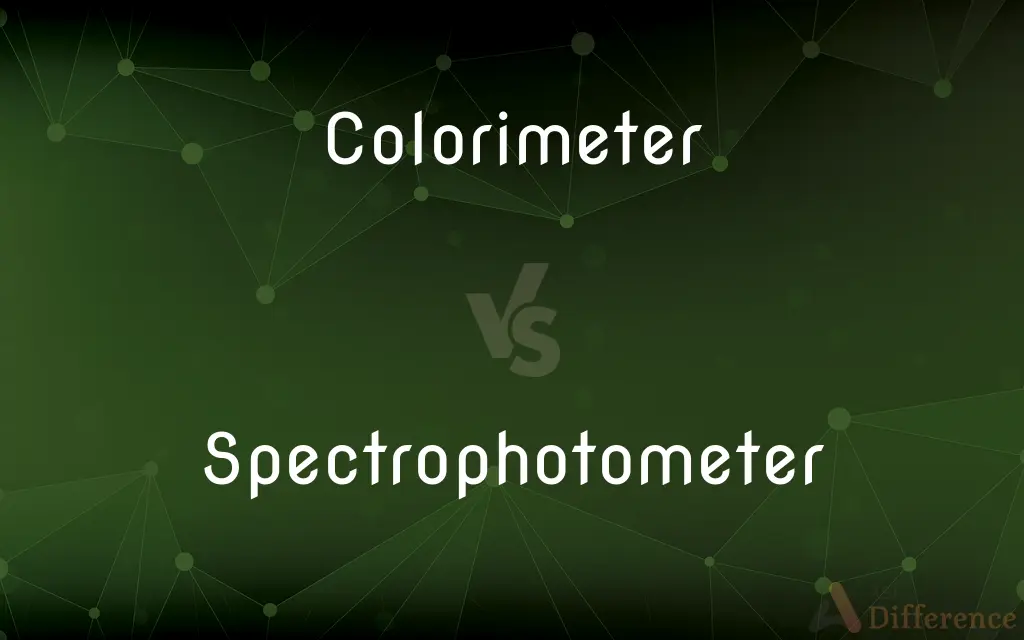Colorimeter vs. Spectrophotometer — What's the Difference?
By Urooj Arif & Maham Liaqat — Updated on March 20, 2024
A colorimeter measures light absorbance at specific wavelengths for color intensity, while a spectrophotometer assesses light intensity across a broad spectrum for detailed absorption properties.

Difference Between Colorimeter and Spectrophotometer
Table of Contents
ADVERTISEMENT
Key Differences
A colorimeter is a straightforward instrument designed primarily to assess the concentration of colored compounds in a solution by measuring the absorbance of light at a specific wavelength or a narrow band of wavelengths. It usually relies on predefined filters to select the wavelength, making it suitable for a limited range of experiments where the substance's color directly correlates with its concentration. On the other hand, a spectrophotometer is a more versatile and sophisticated device that can measure light absorbance or transmittance across a wide range of wavelengths, allowing for a comprehensive analysis of the substance's absorption spectrum.
Colorimeters are typically simpler in design and operation, making them accessible and cost-effective for educational purposes and basic color analysis in industries like food and beverage, where specific color standards are crucial. They work on the principle of Beer-Lambert's law, correlating the absorbance of light to the concentration of the solution. In contrast, spectrophotometers, which also operate based on Beer-Lambert's law, offer higher precision and flexibility, featuring adjustable wavelength selection, often through a monochromator, and are used in more complex analyses in fields such as biochemistry, physics, and environmental science.
The application scope of colorimeters is somewhat limited by their dependence on the color of solutions and the availability of appropriate filters for the wavelength of interest. Spectrophotometers, with their broad wavelength range, are capable of analyzing colorless and colored substances alike, providing detailed spectral data that can be used for qualitative and quantitative analysis, including the study of concentration, purity, and molecular bonding.
While colorimeters provide a direct and quick way to determine the concentration of colored solutions, making them suitable for high-throughput and routine analyses in certain applications, spectrophotometers offer in-depth analytical capabilities, including the ability to scan entire spectra, analyze peak absorbance, and even deduce molecular structures in some cases. This makes spectrophotometers essential in research and advanced analytical laboratories.
Despite their differences, both instruments share the common goal of analyzing substances through their interaction with light. The choice between a colorimeter and a spectrophotometer largely depends on the specific requirements of the analysis, including the level of detail needed, the nature of the substances being analyzed, and the intended application of the data obtained.
ADVERTISEMENT
Comparison Chart
Principle of Operation
Measures absorbance of light at specific wavelengths
Measures absorbance/transmittance across a spectrum
Complexity
Simple, with fixed filters
Advanced, with adjustable wavelength selection
Use Cases
Concentration measurement of colored compounds
Broad range, including structure analysis, kinetics
Flexibility
Limited to available filter wavelengths
High, due to wide wavelength range
Applications
Food and beverage industry, education
Biochemistry, physics, environmental science
Analysis Capability
Direct concentration determination
Detailed spectral analysis, qualitative and quantitative
Cost
Generally lower
Higher due to advanced features and capabilities
Compare with Definitions
Colorimeter
Colorimeters are suited for educational purposes and simple color analysis.
Students used a colorimeter in their chemistry lab to measure the concentration of food coloring in water.
Spectrophotometer
A spectrophotometer measures light absorption across a spectrum to analyze a substance's properties.
The lab used a spectrophotometer to identify the unknown compound based on its absorption spectrum.
Colorimeter
A colorimeter measures the intensity of color in a solution to determine its concentration.
A colorimeter was used to assess the concentration of copper sulfate by its blue color intensity.
Spectrophotometer
The device provides flexibility in selecting wavelengths for comprehensive analysis.
The spectrophotometer's monochromator allowed for precise selection of wavelengths to study the photosynthetic pigments.
Colorimeter
Colorimeters are limited by the need for the substance to be colored.
The colorimeter couldn't be used to measure the sugar content in water due to the lack of color.
Spectrophotometer
Spectrophotometers are essential in advanced research and analysis.
The environmental agency used a spectrophotometer to detect pollutants in water samples by their spectral fingerprints.
Colorimeter
It uses specific filters to select the wavelength of light for analysis.
The colorimeter's green filter was ideal for analyzing the red dye in the solution.
Spectrophotometer
It offers detailed analysis, including peak absorbance and spectrum scanning.
Researchers utilized a spectrophotometer to study the reaction kinetics by observing spectral changes over time.
Colorimeter
The device is straightforward and cost-effective for routine tests.
The brewery relies on a colorimeter to ensure consistent color in its beer products.
Spectrophotometer
It can analyze both colored and colorless substances.
A spectrophotometer was used to measure the protein concentration in a clear solution using UV absorption.
Colorimeter
Any of various instruments used to determine or specify colors, as by comparison with spectroscopic or visual standards.
Spectrophotometer
An instrument used to determine the relative intensity of various wavelengths in a spectrum of light.
Colorimeter
An instrument that measures the concentration of a known constituent of a solution by comparison with colors of standard solutions of that constituent.
Spectrophotometer
(physics) An instrument used to measure the intensity of electromagnetic radiation at different wavelengths.
Colorimeter
Any of various instruments designed to determine the color of something, by comparison with standard colors or by spectroscopy.
Spectrophotometer
An instrument for measuring or comparing the intensities of the colors of the spectrum.
Colorimeter
(analytical chemistry) An analytic instrument that estimates the concentration of a substance in a sample by measuring its color against the solution's complementary color.
Spectrophotometer
An analytical instrument for measuring the degree of absorption of light at different wavelengths by a chemical substance. A specific pattern of absorption intensities at a series of wavelengths is a characteristic of each different chemical substance.
Colorimeter
An instrument for measuring the depth of the color of anything, especially of a liquid, by comparison with a standard liquid.
Spectrophotometer
A photometer for comparing two light radiations wavelength by wavelength
Colorimeter
A measuring instrument used in colorimetric analysis to determine the quantity of a substance from the color it yields with specific reagents
Common Curiosities
How do scientists choose between a colorimeter and a spectrophotometer for a particular analysis?
The choice depends on the analysis's requirements, including the level of detail needed, the nature of the substances being analyzed, and the intended application. For simple, routine analyses of colored substances, a colorimeter may suffice, while for more detailed studies, a spectrophotometer is preferred.
Can a colorimeter analyze colorless solutions?
Typically, no. Colorimeters are designed for colored solutions, as they measure the intensity of a specific color to determine concentration.
What makes spectrophotometers more expensive than colorimeters?
Spectrophotometers are more complex, offering a broader range of features and capabilities, such as adjustable wavelength selection and detailed spectral analysis, which contribute to their higher cost.
Is it possible to modify a colorimeter to measure a wider range of wavelengths?
Colorimeters are limited by their fixed filters, and while additional filters can sometimes be added, they cannot match the broad, adjustable range of a spectrophotometer.
How does the Beer-Lambert Law apply to both colorimeters and spectrophotometers?
The Beer-Lambert Law, stating that absorbance is proportional to concentration, underlies the operation of both colorimeters and spectrophotometers, enabling them to determine the concentration of solutions based on light absorption.
Can a spectrophotometer be used for simple concentration measurements like a colorimeter?
Yes, a spectrophotometer can perform simple concentration measurements in addition to more complex analyses, making it versatile.
What is the role of a monochromator in a spectrophotometer?
A monochromator in a spectrophotometer selects specific wavelengths of light from a broad spectrum, allowing for precise analysis of the sample's absorption characteristics at those wavelengths.
How do advancements in digital technology enhance the functionality of spectrophotometers?
Digital technology, including software integration and automation, enhances spectrophotometers by enabling more sophisticated data analysis, user-friendly interfaces, and automation of repetitive tasks for improved accuracy and efficiency.
Why is a colorimeter considered more suitable for educational purposes?
Due to its simplicity, ease of use, and lower cost, a colorimeter is more accessible for educational settings where basic principles of light absorption and concentration measurement are taught.
How does a spectrophotometer contribute to environmental science?
Spectrophotometers can detect and quantify various pollutants in environmental samples by analyzing their unique absorption spectra, aiding in environmental monitoring and research.
How do colorimeters and spectrophotometers contribute to quality control in industries?
In industries like food, beverage, and pharmaceuticals, these devices ensure product consistency and compliance with standards by measuring concentrations and properties of color and other substances.
Can the data from a spectrophotometer be used to deduce molecular structure?
Yes, the detailed absorption spectrum obtained from a spectrophotometer can provide insights into molecular structure, such as functional groups and bonding, based on specific absorbance patterns.
What is the significance of the light source in a colorimeter and spectrophotometer?
The light source is crucial in both devices, providing the initial light that interacts with the sample. In spectrophotometers, the light source must cover a broad spectrum for versatile analysis, while in colorimeters, it must be compatible with the selected filters.
Why is sample preparation important for accurate measurements with colorimeters and spectrophotometers?
Proper sample preparation, such as dilution and filtration, is essential to avoid interference and ensure that the measurement reflects the true concentration or characteristics of the analyte.
Share Your Discovery

Previous Comparison
Footballist vs. Footballer
Next Comparison
Symport vs. AntiportAuthor Spotlight
Written by
Urooj ArifUrooj is a skilled content writer at Ask Difference, known for her exceptional ability to simplify complex topics into engaging and informative content. With a passion for research and a flair for clear, concise writing, she consistently delivers articles that resonate with our diverse audience.
Co-written by
Maham Liaqat















































